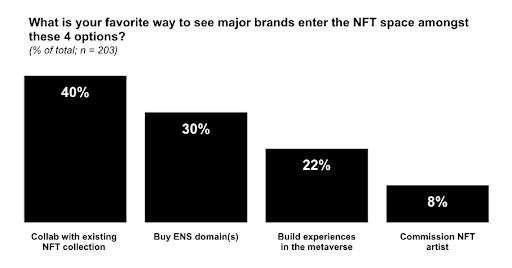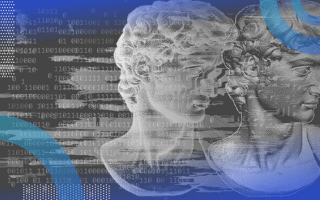In 2021, NFTs began to enter mainstream conversation. “Non-fungible token” was Collins Dictionary’s 2021 word of the year. We saw eight-figure digital art auctions, cartoon JPEGs take over Times Square, and an exponentially growing list of brands, celebrities and athletes announcing their involvement in the space. Like the early moments of the internet, this emerging corner of the world is full of passionate discourse, strange experimentation and overwhelming innovation.
I expect the NFT market to mature a bit in 2022 as speculation fades and the technology’s utility grows, and while I’m not making any predictions in this piece, at VaynerNFT remain highly convicted (yet measured) in our approach to advising major brands and IP owners of all types. We’re in early days and uncharted waters. We see major opportunities for broad commercialization; our clients do, too.
What Makes a Valuable NFT?
- High-quality artwork (the JPEG)
- Online and offline utility for tokenholders
- Community engagement
These are the core tenets of my perspective for executives new to NFTs. There is plenty of great educational content out there, and this is just one piece of the puzzle. So, whether this is your first NFT article or your fiftieth, I hope to help cut through the noise to highlight a few of the key elements of the NFT world that ought to matter to marketers, technologists and brand executives.
The Aha Moment: Digital Assets + Digital Ownership
First, a quick parallel.
Let’s say you own a pair of Nike sneakers. If Nike were to go out of business tomorrow, you would surely (and obviously) still own your shoes — it’s easy to understand ownership of physical assets. In the digital world, though, the notion of ownership hasn’t really existed — we simply don’t own much of our digital footprint yet. What happens to your inbox and contact list if Gmail goes down? What happens to your Facebook friends or photos if Meta closes up shop? If you play hours and hours of an online game like Fortnite and upgrade to an exclusive item like a jetpack, who owns that jetpack — you or Fortnite? Can you take it with you once you’re done playing their game?
The idea of digital assets isn’t new, but your ability to actually own them is. Without diving into the technical nuances of blockchain and decentralization, Web3 is allowing for both ownership of digital assets and for natively digital value to be associated with those digital assets. In today’s (very early) form of Web3, you actually own the token representation of the JPEG in your wallet, and it genuinely has value determined by an open market. Tomorrow, that JPEG might be a deed to a house, a gym membership, a concert ticket or a vaccine card. Verifiable digital asset ownership opens the door to a host of potential paradigm shifts across both the physical and digital worlds.
As a seller of digital assets, your company can also consider potential future revenue streams coming from secondary market sales. Each NFT can be programmed (you may have heard of smart contracts) to send a small transaction fee back to the original creator anytime it trades hands in a sale. This new annuity absolutely changes the revenue model for artists, but it also has disruptive potential anywhere a lively secondary market exists — from event ticketing to fine liquor collecting to in-game digital items.
How to Prepare Your Business for Web3
- Establish digital wallet infrastructure and accept crypto
- Partner with the NFT community
- Articulate clear legal and regulatory positions
- Develop a top-down Web3 strategy
A Mental Model for NFTs Today: Artwork + Utility + Community
NFTs are an ownable ( typically scarce) digital asset. The winning NFT recipe of today is equal parts high-quality artwork, online and offline utility for token holders, and strong community engagement and activation. Let’s deep-dive on each component to establish a common mental model.
High-Quality Artwork (the JPEG)
Most NFTs today are centered around some thematic artwork, usually by a notable or emerging digital artist. Within any given NFT collection there are typically variations on the theme. In profile picture (PFP) collections, the most ubiquitous NFT theme today, each character may look slightly different: One may have red hair, one may have sunglasses, one may hold a lightsaber. The combination of various traits establishes any given NFT’s personality and its rarity within the collection. Of course, each NFT’s price generally follows its rarity — the more rare the trait combo, the more valuable the market usually decides it ought to be.
This same concept applies to other winning NFT themes in gaming, sports and collectibles — high-quality artwork is (almost) always a key feature of a successful NFT program.
Online and Offline Utility for Tokenholders
NFT collections are increasingly valued based on the level of utility given by the governing team to their tokenholders. Brands should be building long-term NFT programs that provide real utility to their community of owners, not one-time NFT drops focused on splashy PR. Utility, though, is a broadly defined measure. Among many things, an NFT’s utility often represents:
- Access - to celebrities or influencers, to VIP engagements, to token-gated websites or merchandise, to vote on community decisions, etc.
- Rewards - product or service discounts, exclusive merch giveaways, early access to new products, rewards programs to incentivize certain behaviors (e.g. loyalty, social engagement), etc.
- One-time experiences - online activations (e.g. a metaverse concert), in-person parties and events, annual conferences, behind-the-scenes tours, etc.
- Status - Through a combination of any of the above, simply owning a specific NFT can convey a certain social status like a Rolex, a Tesla or a wine collection might in the physical world.
Community Engagement
The foundation of success for an NFT collection is the strength of its community. If you believe that brand marketing has evolved from transactional to experiential to interactive over the last two decades, then you’ll agree that today, engaging your community is the absolute key to successful brand marketing. In fact, many early NFT projects were bootstrapped by their communities themselves. Bored Ape Yacht Club, one of the more prominent NFT collections, certainly has a founding team, but its highly-engaged community is the reason you see it on Times Square billboards, on the cover of Rolling Stone and why it is now a growing, global brand.
Celebrities have joined the community and added their ethos to the project. Owners with careers in marketing, law, finance and the arts have called on their unique skill sets and networks to enhance the brand. As traditional corporate America enters the NFT space, it must recognize the power, and perhaps the requirement, of empowering the community to engage, to build and to grow.
Web3 Readiness: Operational Considerations
At VaynerNFT, we believe this is a major commercial opportunity for brands and IP owners, but we want new entrants to consider the growth potential with eyes wide open. Appreciating the operational complexity, establishing cross-functional communication channels and planning for proper infrastructure are absolutely critical first steps. This coordination will span from treasury to tax, from IT to legal, and it will likely require a crypto task force with explicit top-down support. Here are several of the early steps I have seen our most thoughtful (and successful) clients take:
 Establish Digital Wallet Infrastructure and Accept Crypto: As an organization, you cannot store your NFTs and your crypto in your traditional bank account. Plenty of custodial, payment and technology partners exist to help facilitate crypto infrastructure within large enterprises, but organizations will have to recognize the need for an entirely new tech stack and internal controls for crypto.
Establish Digital Wallet Infrastructure and Accept Crypto: As an organization, you cannot store your NFTs and your crypto in your traditional bank account. Plenty of custodial, payment and technology partners exist to help facilitate crypto infrastructure within large enterprises, but organizations will have to recognize the need for an entirely new tech stack and internal controls for crypto.
 Partner With the NFT Community — Marketplaces, Artists and Tastemakers: Beyond core infrastructure, partnerships are paramount to operationalizing successful NFT programs. We have discussed the notion of authenticity and the community, and new entrants will do well to find smart partners to lend legitimacy and signal you’ve done your homework. See below for a community poll on this topic to help prioritize your partnership strategies.
Partner With the NFT Community — Marketplaces, Artists and Tastemakers: Beyond core infrastructure, partnerships are paramount to operationalizing successful NFT programs. We have discussed the notion of authenticity and the community, and new entrants will do well to find smart partners to lend legitimacy and signal you’ve done your homework. See below for a community poll on this topic to help prioritize your partnership strategies.
 Articulate Clear Legal and Regulatory Positions: Regulatory guidance is still sparse in this field. Major organizations have taken a variety of different internal stances and positions on their appetite for participation and their tolerance for ambiguity. My (non-legal) advice is to convey the commercial opportunity to your lawyers ASAP and put them to work in developing your organization’s position.
Articulate Clear Legal and Regulatory Positions: Regulatory guidance is still sparse in this field. Major organizations have taken a variety of different internal stances and positions on their appetite for participation and their tolerance for ambiguity. My (non-legal) advice is to convey the commercial opportunity to your lawyers ASAP and put them to work in developing your organization’s position.
 Develop a Top-Down Web3 Strategy: The sale of an NFT is the beginning of a new community relationship, not the end of a traditional merchandise transaction. Executives need to be thinking 5 years ahead, not five weeks. Developing an upfront strategy, a set of core principles and a measured approach to experimentation are necessary first steps. This space is full of noise and distraction, and your organization needs to move in lockstep.
Develop a Top-Down Web3 Strategy: The sale of an NFT is the beginning of a new community relationship, not the end of a traditional merchandise transaction. Executives need to be thinking 5 years ahead, not five weeks. Developing an upfront strategy, a set of core principles and a measured approach to experimentation are necessary first steps. This space is full of noise and distraction, and your organization needs to move in lockstep.

* * *
Notes:
- Our team holds many NFTs and cryptocurrencies including several of the ones discussed here.
- To crypto-native readers: Yes, there are times we are over-simplifying for the sake of our core executive audience who is likely new to the space. We, of course, are interested in and advising our clients on more sophisticated tokenomics, fractionalization, staking, P2E and the metaverse. Don’t worry, I get it.
- Thank you and credit to flaticon.com for the open source icon library.
- All the data and information contained herein is accurate at the time of publication.





